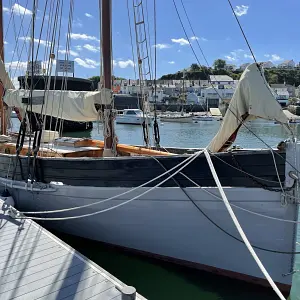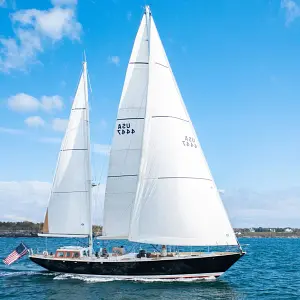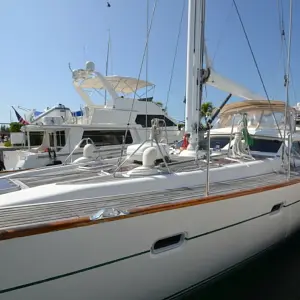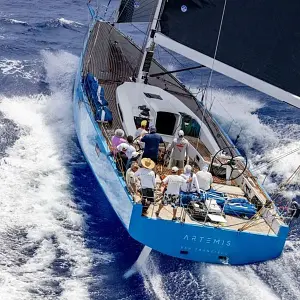42′ Looe Lugger Our Boys
Owner Comments on sailing Our Boys
When we were thinking of buying Our Boys, I had heard talk about luggers being difficult to sail and coming from a Gaff cutter background, I thought about converting Our Boys to gaff-rig. However, on sailing Our Boys, we quickly discovered that the rumours about luggers being difficult to sail certainly did not apply to this boat.
42′ Looe Lugger Our Boys
Owner Comments on sailing Our Boys
When we were thinking of buying Our Boys, I had heard talk about luggers being difficult to sail and coming from a Gaff cutter background, I thought about converting Our Boys to gaff-rig. However, on sailing Our Boys, we quickly discovered that the rumours about luggers being difficult to sail certainly did not apply to this boat. As anyone who has sailed a large gaff rigged yacht will testify, because of the huge boom, running back-stays etc, in particular gybing can be a bit fraught. As Our Boys is a standing lug on both masts and has no boom or back-stays, when gybing, the sails merely flop across the other side with no effort at all apart from releasing one sheet and taking up on the other. I believe that the rumours about them being difficult comes from the original dipping lug type rig, which involves lowering and raising the main sail every time one tacks or gybes; however, this is not the case on a standing lug. We almost always sail with just the two of us so were looking for a boat which could be easily handled by a crew of two. In this respect, Our boys has been the perfect choice. All of the sails are sheeted on to winches; the main sail is sheeted just like a genoa, with one sheet each side, led onto winches; the jib (there is no stay-sail), is furling so can be deployed and recovered quickly and again, the sheets are led to self-tailing winches. The mizzen sail only has one sheet which is also led to a self-tailing winch. Hoisting the sails again is not too strenuous as the yards are GRP hollow spars so not as heavy as the traditional wooden spars. Another advantage of he lug rig is that because of the lack of rigging, the main and mizzen sails can be hoisted and lowered without it being necessary to be head-to-wind. The two of us have now cruised Our Boys for nearly 9 years, from Plymouth to Southern Brittany, the Scilly Isles and the north coast of Brittany, and attended the many classic boat festivals along the way. We have successfully raced her against the other luggers, again sometimes with no additional crew. This year we won our class most convincingly in the Falmouth Classics festival. Owning and sailing Our Boys has been a privilege and a huge pleasure.
Wooden Ships Comments on this Looe Lugger
Built by Pearce of Looe in 1904 to traditional West Country fishing boat lines with a transom and straight stem. She has very fine underwater lines common to the early boats built for sail only. At the time of her build there were 60 boats in the Looe fishing fleet, all sailing out to the fishing grounds on a daily basis to haul their nets and lay the long lines. The design developed from many years of building these boats with ideas and techniques passed from generation to generation, these early sail only boats being exceptionally fast if handled correctly and very sea kindly helping the crews work in all conditions.
Built for George Pengelly, a local fisherman, and named after his seven sons, she was put to work in the family fishing business, drift netting for pilchard and herring or long lining for conger and turbot in the spring. She has undergone several changes over the years to adapt to the changing fishing industry, including the installation of her first engine in 1912. During World War 2 she was a guard ship for the Looe fishing fleet, and until the quite recent replacement of her deck she still had the fittings bolted on the foredeck to carry the machine gun. She fished commercially until the mid 1970’s at which point she was a twin engine motor fishing vessel with a small wheelhouse and gaff mizzen sail to help with directional stability while hauling nets.
At this stage she was sold out of fishing and first converted to a private yacht, but has since undergone several transformations, most recently in 2014 with the current owners who fitted a larger coachroof and a new interior, which at the same time allowed them to inspect the complete interior hull structure. In 2015 the hull was re-fastened completely with galvanised screws and various planks replaced as necessary.
The rig has been adapted and altered to make it as simple to use as possible, the boat is regularly cruised and raced with just 2 people aboard, and although self tailing winches may not be traditional, they help to make her a practical and user friendly cruising boat for modern times. She has been cruised extensively from southern Brittany, the Scillies and the south coast of England, and has attended numerous traditional boat festivals and regattas, always a popular boat and won her class convincingly at the 2022 Falmouth Classics. Our Boys is known to be a fast boat and her pedigree as an engine-less fishing boat is clear to see as she eats up the miles with ease.
October 2022 buyers survey available on request.
Length on Deck 42’
Length Overall 70’ approx
Beam 13’
Draft 6’
Construction
Planked in 1.25” pitch pine fastened with galvanised wood screws to 4” x 3” sawn oak frames at 13” centres.
In the 2015 refit the boat was completely re-fastened. The old nail fastenings were not removed for fear of causing excessive damage to the planking will trying to extract them. Some new planking was fitted, mainly around the sheer strake using iroko.
Greenheart keel fitted in the 1980’s.
Sawn oak floors side bolted through the frames.
All internal ballast in the form of iron pigs.
Transom replaced in 2021 using iroko. Transom hung rudder.
Straight laid solid iroko deck screwed to the deck beams, caulked and payed with sikaflex. Iroko covering board with oak stanchions mounted through it. Various sections of the covering board and some stanchions replaced in the 2015 refit. Iroko capping rail.
Coachroof finished at a similar height to the bulwark which was completely new in 2014. Heavy iroko coamings with dovetail corners. Coachroof deck on oak deck beams constructed from marine ply overlaid with iroko deck planks and a varnished iroko margin board. Large bronze portlights in the coamings with an iroko butterfly skylight on the centreline.
New iroko butterfly skylight fitted over the aft cabin to improve headroom and light.
Small lazarette hatch in the aft deck and a forehatch extending off the forward end of the coachroof to give better headroom in part of the owners cabin.
Rig
2 mast standing lug rig on solid pine masts.
The rig has been optimised for short handed sailing with self tailing winches where necessary and modern materials to reduce weight. The result is a very efficient and easily handled rig that defies the usual stereotypical views of this type of rig.
GRP lug yards for weight reduction. Pine bumpkin and bowsprit.
In 2021 the masts were unstepped and inspected thoroughly.
Standing rigging of galvanised wire, all new in 2021. Swaged eyes with block and tackle tensioning to galvanised eye bolts through the deck.
Mainmast has a pair of shrouds to starboard with ratlines fitted. Port side is a single shroud, assisted by the main halyard when the sail is set in the usual lug manner.
Mizzen mast has a single shroud either side.
Bowsprit fitted with whisker stays in galvanised wire and a chain bobstay. Harken roller furling system fitted to the bowsprit for the headsail. Bowsprit can be run inboard and rests on the coachroof to reduce overall length.
Pair of Anderson 28 self tailing 2 speed headsail sheet winches
Pair of Lewmar 48 self tailing mainsheet winches mounted on the bulwark aft
Single Lewmar 40 self tailing mizzen sheet winch sheet winch mounted on the inner end of the bumpkin
Various sail combinations including 3 different sized mizzen sails, 5 headsails and a mainsail
Machinery
Twin NissanLD20 55hp 4cyl fresh water cooled diesel engines installed new in 2010 and 2011.
Vessel comes with a complete spare engine and numerous spares.
PRM Delta 20 gearboxes with single lever controls. Stainless shafts to a pair of 2 blade folding propellers give 6 knots cruising speed.
2 x 150 litre stainless steel fuel tanks back aft. Separate Racor fuel filters for each engine.
500 litre water tank.
3 x 120ah domestic batteries and 1 x 120ah engine start battery. Charged from both engine alternators with a Sterling split charge system.
Large solar panel with regulator and a shore power system with 30 amp 240 volt charger.
Accommodation
The interior was replaced entirely in 2013 apart from the spacious aft cabin which was left as before. The joinery is all solid timber with painted T&G trimmed in solid oak.
9 berths including a double owners cabin forward, 2 double berths in the aft cabin and a single pilot berth in the saloon, plus a single saloon settee berth that can form a double using the saloon table. Excellent headroom under the coachroof.
Steps down from the companion hatch into the main cabin with a heads compartment to port and chart desk to starboard.
Chart desk faces outboard with switch panel outboard.
Heads compartment has Jabsco manual sea toilet which discharges directly overboard. Stainless hand basin with hot and cold pressurised water. GRP shower tray with a shower head.
The main saloon has a large galley along the starboard side and a U-shaped seating area to port.
The saloon seating can be used as a single berth, with the saloon table lowering to be the base of a double berth if required. Moveable stool allows another 2 people to sit around the table. Pilot berth outboard to port under the side decks.
Galley joinery is all solid oak with a Force 10 2 burner gas stove with oven and grill. Single stainless steel sink with pressurised hot and cold water. Waeco 12 volt fridge. Numerous storage lockers and shelves around the galley.
Reflex diesel fired cabin heater to starboard.
Starboard side door going forward into the owners cabin. Small seating area to starboard and heads compartment to port. Heads compartment has Jabsco manual sea toilet which discharges directly overboard. Stainless hand basin with hot and cold pressurised water. GRP shower tray with a shower head.
Double owners berth to port with numerous storage lockers around the cabin.
Access to the forepeak around the bulkhead with space for warp and fender storage. Chain locker is a vertical box to starboard.
The aft cabin is accessed by the companion steps and has a small double berth either side with the engine boxes at the forward end. Skylight above for improved headroom and ventilation.








